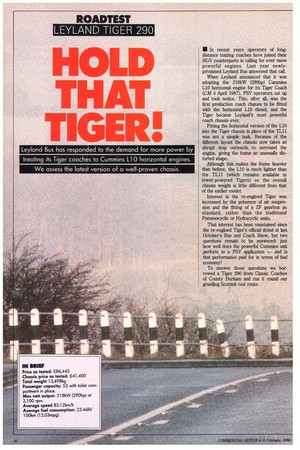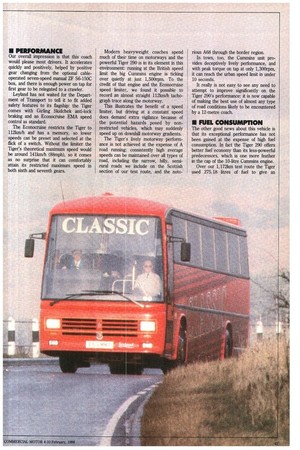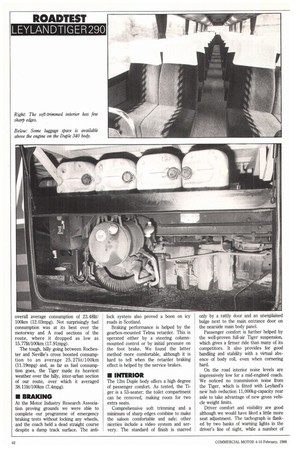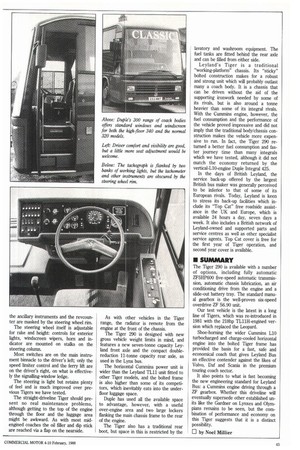• HOLD THAT
Page 42

Page 43

Page 44

Page 45

If you've noticed an error in this article please click here to report it so we can fix it.
Leyland Bus has responded to the demand for more power by treating its Tiger coaches to Cummins L10 horizontal engines. We assess the latest version of a well-proven chassis.
• In recent years operators of longdistance touring coaches have joined their HGV counterparts in calling for ever more powerful engines. Last year newlyprivatised Leyland Bus answered that call.
When Leyland announced that it was adopting the 216kW (290hp) Cummins L10 horizontal engine for its Tiger Coach (CM 4 April 19871), PSV operators sat up and took notice. This, after all, was the first production coach chassis to be fitted with the horizontal L10 diesel, and the Tiger became Leyland's most powerful coach chassis ever.
Fitting the horizontal version of the L10 into the Tiger chassis in place of the TL11 was not a simple task. Because of the different layout the chassis now takes an abrupt step outwards to surround the engine, giving the frame an unusually distorted shape.
Although this makes the frame heavier than before, the L10 is much lighter than the TL11 (which remains available in lower-powered Tigers) so the overall chassis weight is little different from that of the earlier rnodel.
Interest in the re-engined Tiger was increased by the presence of air suspension and the fitting of a ZF gearbox as standard, rather than the traditional Pneurnocyclic or Hydracyclic units.
That interest has been maintained since the re-engined Tiger's official debut at last October's Bus and Coach Show, but two questions remain to be answered: just how well does the powerful Cummins unit perform in a PSV application — and is that performance paid for in terms of fuel economy?
To answer those questions we borrowed a Tiger 290 from Classic Coaches of County Durham and ran it round our gruelling Scottish test route.
• PERFORMANCE
Our overall impression is that this coach would please most drivers. It accelerates quickly and positively, helped by positive gear changing from the optional cableoperated seven-speed manual ZF S6-150C box, and there is enough power on tap for first gear to be relegated to a crawler.
Leyland has not waited for the Department of Transport to tell it to fit added safety features to its flagship: the Tiger comes with Girling Skidchek anti-lock braking and an Econocruise EMA speed control as standard.
The Econocruise restricts the Tiger to 112km/h and has a memory, so lower speeds can be preset and selected at the flick of a switch. Without the limiter the Tiger's theoretical maximum speed would be around 141km/h (88mph), so it comes as no surprise that it can comfortably attain its restricted maximum speed in both sixth and seventh gears. Modern heavyweight coaches spend much of their time on motorways and the powerful Tiger 290 is in its element in this environment: running at the British speed limit the big Cummins engine is ticking over quietly at just 1,500rpm. To the credit of that engine and the Econocruise speed limiter, we found it possible to record an almost straight 112km/h tachograph trace along the motorway.
This illustrates the benefit of a speed limiter, but driving at a constant speed does demand extra vigilance because of the potential hazards posed by nonrestricted vehicles, which may suddenly speed up on downhill motorway gradients.
The Tiger's lively motorway performance is not achieved at the expense of A road running: consistently high average speeds can be maintained over all types of road, including the narrow, hilly, semirural roads we include on the Scottish section of our test route, and the noto
rious A68 through the border region.
In town, too, the Cummins unit provides deceptively lively performance, and with peak torque on tap at only 1,300rpm, it can reach the urban speed limit in under 10 seconds.
It really is not easy to see any need to attempt to improve significantly on the Tiger 290's performance: it is now capable of making the best use of almost any type of road conditions likely to be encountered by a 12-metre coach.
• FUEL CONSUMPTION
The other good news about this vehicle is that its exceptional performance has not been gained at the expense of high fuel consumption. In fact the Tiger 290 offers better fuel economy than its less-powerful predecessors, which is one more feather in the cap of the 10-litre Cummins engine.
Over our 1,172km test route the Tiger used 275.18 litres of fuel to give an overall average consumption of 23.48Iit/ 100km (12.03mpg). Not surprisingly fuel consumption was at its best over the motorway and A road sections of the route, where it dropped as low as 15. 771it/100km (17. 91mpg).
The tough, hilly going between Rochester and Neville's cross boosted consumption to an average 25.271it/100km (11.19mpg) and, as far as fuel consumption goes, the Tiger made its heaviest weather over the hilly, inter-urban section of our route, over which it averaged 38.111k/100km (7.4mpg).
• BRAKING
At the Motor Industry Research Association proving grounds we were able to complete our programme of emergency braking tests without locking any wheels, and the coach held a dead straight course despite a damp track surface. The anti lock system also proved a boon on icy roads in Scotland.
Braking performance is helped by the gearbox-mounted Telma retarder. This is operated either by a steering columnmounted control or by initial pressure on the foot brake. We found the latter method more comfortable, although it is hard to tell when the retarder braking effect is helped by the service brakes.
• INTERIOR
The 12m Duple body offers a high degree of passenger comfort. As tested, the Tiger is a 53-seater; the toilet compartment can be removed, making room for two extra seats.
Comprehensive soft trimming and a minimum of sharp edges combine to make the saloon comfortable and safe; other niceties include a video system and servery. The standard of finish is marred only by a rattly door and an unexplained bulge next to the main entrance door on the nearside main body panel.
Passenger comfort is further helped by the well-proven full-air Tiger suspension, which gives a firmer ride than many of its competitors. It also provides for good handling and stability with a virtual absence of body roll, even when cornering hard.
On the road interior noise levels are impressively low for a mid-engined coach. We noticed no transmission noise from the Tiger, which is fitted with Leyland's new hub reduction 11,000kg-capacity rear axle to take advantage of new gross vehicle weight limits.
Driver comfort and visibility are good although we would have liked a little more seat adjustment. The tachograph is flanked by two banks of warning lights in the driver's line of sight, while a number of the ancillary instruments and the revcounter are masked by the steering wheel rim.
The steering wheel itself is adjustable for rake and height: controls for exterior lights, windscreen wipers, horn and indicator are mounted on stalks on the steering column.
Most switches are on the main instrument binnacle to the driver's left; only the speed limiter control and the ferry lift are on the driver's right, on what is effectively the signalling-window ledge.
The steering is light but retains plenty of feel and is much improved over previous Tigers we have tested.
The straight-driveline Tiger should present no real maintenance problems, although getting to the top of the engine through the floor and the luggage area might be awkward. As with most midengined coaches the oil filler and dip stick are reached via a flap on the nearside. As with other vehicles in the Tiger range, the radiator is remote from the engine at the front of the chassis.
The Tiger 290 is designed with new gross vehicle weight limits in mind, and features a new seven-tonne capacity Leyland front axle and the compact doublereduction 11-tonne capacity rear axle, as used in the Lynx bus.
The horizontal Cummins power unit is wider than the Leyland TL11 unit fitted to other Tiger models, and the bolted frame is also higher than some of its competitors, which inevitably eats into the underfloor luggage space.
Duple has used all the available space to advantage, however, with a useful over-engine area and two large lockers flanking the main chassis frame to the rear of the engine.
The Tiger also has a traditional rear boot, but space in this is restricted by the lavatory and washroom equipment. The fuel tanks are fitted behind the rear axle and can be filled from either side.
Leyland's Tiger is a traditional "working-platform" chassis. Its "sticky" bolted construction makes for a robust and strong unit which will probably outlast many a coach body. It is a chassis that can be driven without the aid of the supporting ironwork needed by some of its rivals, but is also around a tonne heavier than some of its integral rivals. With the Cummins engine, however, the fuel consumption and the performance of the vehicle proved impressive and did not imply that the traditional body/chassis construction makes the vehicle more expensive to run. In fact, the Tiger 290 returned a better fuel consumption and faster journey time than many integrals which we have tested, although it did not match the economy returned by the vertical-L10-engine Duple Integral 425.
In the days of British Leyland, the service back-up offered by the largest British bus maker was generally perceived to be inferior to that of some of its European rivals. Today, Leyland is keen to stress its back-up facilities which include its "Top Cat" free roadside assistance in the UK and Europe, which is available 24 hours a day, seven days a week. It also includes a British network of Leyland-owned and supported parts and service centres as well as other specialist service agents. Top Cat cover is free for the first year of Tiger operation, and second year cover is available.
• SUMMARY
The Tiger 290 is available with a number of options, including fully automatic ZF5HP600 five-speed automatic transmission, automatic chassis lubrication, an air conditioning drive from the engine and a slide-out battery tray. The standard manual gearbox is the well-proven six-speed overdrive ZF S6.90 unit.
Our test vehicle is the latest in a long line of Tigers, which was re-introduced in 1981 with the 218hp TL11H-engined version which replaced the Leopard.
Shoe-horning the wider Cummins L10 turbocharged and charge-cooled horizontal engine into the bolted Tiger frame has provided the basis for a fast, safe and economical coach that gives Leyland Bus an effective contender against the likes of Volvo, Daf and Scania in the premium touring coach sector.
It also points to what is fast becoming the new engineering standard for Leyland Bus: a Cummins engine driving through a ZF gearbox. Whether this driveline will eventually supersede other established units like the Gardner on Lynxes and Olympians remains to be seen, but the combination of performance and economy on this Tiger suggests that it is a distinct possibility.
0 by Noel Miltier




















































































